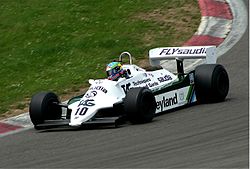Williams FW07B
 |
|||||||||
| Category | Formula One | ||||||||
|---|---|---|---|---|---|---|---|---|---|
| Constructor | Williams Grand Prix Engineering | ||||||||
| Designer(s) |
Frank Dernie Neil Oatley |
||||||||
| Predecessor | FW06 | ||||||||
| Successor | FW08 | ||||||||
| Technical specifications | |||||||||
| Chassis | Aluminium monocoque | ||||||||
| Suspension (front) | Lower wishbones and inboard springs | ||||||||
| Suspension (rear) | Lower wishbones and inboard springs | ||||||||
| Engine | Ford-Cosworth DFV 2,993 cc (182.6 cu in) V8 naturally aspirated mid-mounted | ||||||||
| Transmission |
1979: Hewland FGB 5-speed manual 1980-1982: Hewland FGA 400 5-speed manual |
||||||||
| Weight |
1979: 579 kg 1980: 585 kg 1981-1982: 540 kg |
||||||||
| Fuel | Mobil | ||||||||
| Tyres |
Goodyear (1979-1982) Michelin (1981) |
||||||||
| Competition history | |||||||||
| Notable entrants | Williams | ||||||||
| Notable drivers |
|
||||||||
| Debut | 1979 Spanish Grand Prix | ||||||||
|
|||||||||
| Constructors' Championships | 2 (1980 & 1981) | ||||||||
| Drivers' Championships | 1 (Alan Jones, 1980) | ||||||||
The Williams FW07 was a ground effect Formula One racing car designed by Frank Dernie and Neil Oatley for the 1979 F1 season. It was closely based on the Lotus 79, even being developed in the same wind tunnel at Imperial College London. Some observers, among them Lotus aerodynamicist Peter Wright felt the FW07 was little more than a re-engineered Lotus 79. The car was small and simple and extremely light, powered by the ubiquitous Ford Cosworth DFV. It had very clean lines and seemed to be a strong challenger for the new season, but early reliability problems halted any serious threat for the title. While not the first to use ground effects in Formula One, an honour belonging to Colin Chapman and the Lotus 78 (the Lotus 79's predecessor), Head may have had a better grasp of the principles than even Chapman.
The car made its debut partway through the 1979 season, and served to make Team Williams a contender for perhaps the first time. It was driven by Alan Jones and Clay Regazzoni, who took Williams team's first win in that year's British Grand Prix, before Jones stepped up and won 4 of the next 5 races with the nimble car. Although they lost out to Ferrari in 1979, Williams has established themselves as the team to beat for 1980.
The FW07 became FW07B in 1980, and Regazzoni was replaced by the enigmatic Carlos Reutemann, and while he and Jones formed a successful partnership, they were not comfortable with each other. Both drivers developed the FW07 further, working especially on setup and suspension strengthening. The car was now so efficient in creating downforce from its ground effect design that the front wings were unnecessary. The development worked well. Jones won five races in Argentina, France, Britain, Canada and Watkins Glen in the USA to win his only world championship, while Reutemann won at a wet Monaco. Williams's main challenge came from Nelson Piquet in Brabham's neat BT49, but while Jones won the Drivers' Championship, Williams won their first Constructors' Championship.
...
Wikipedia
